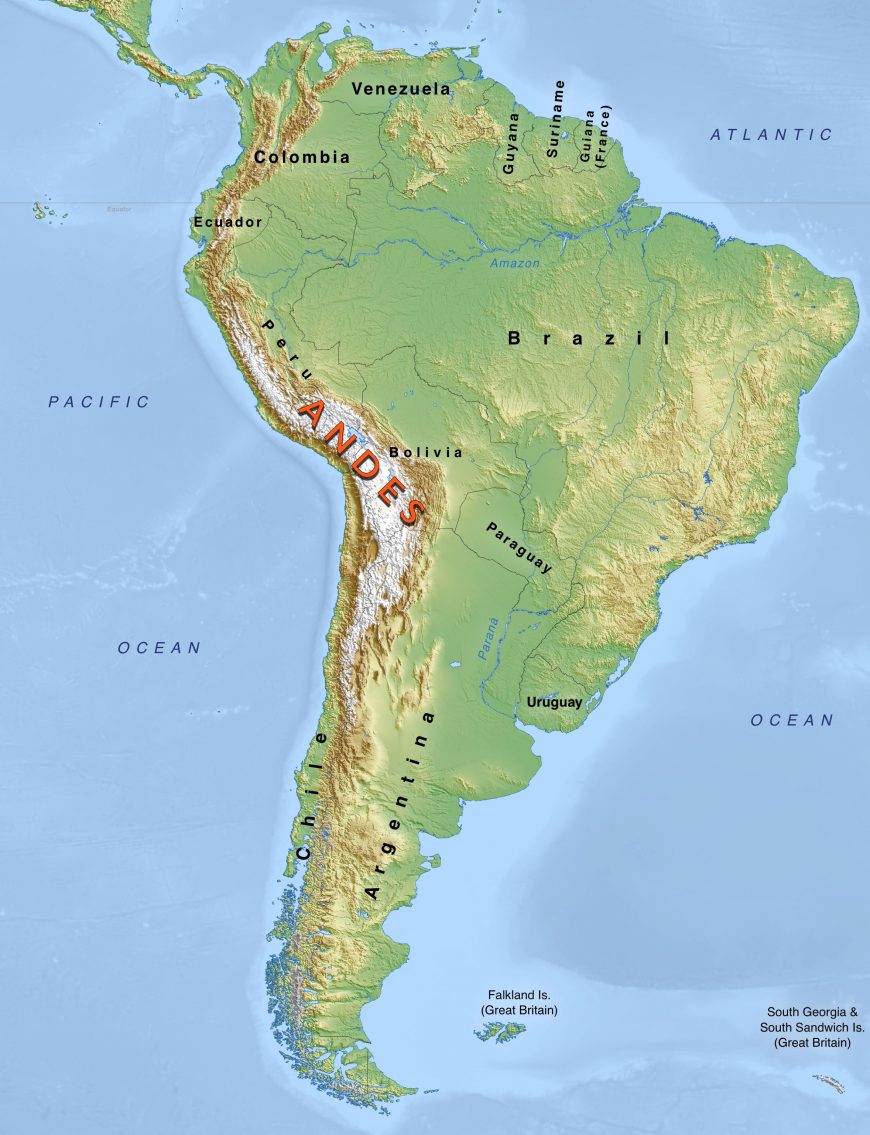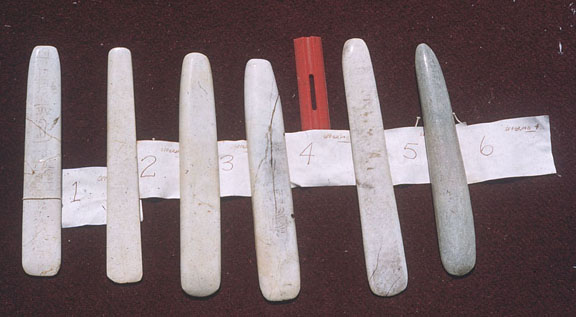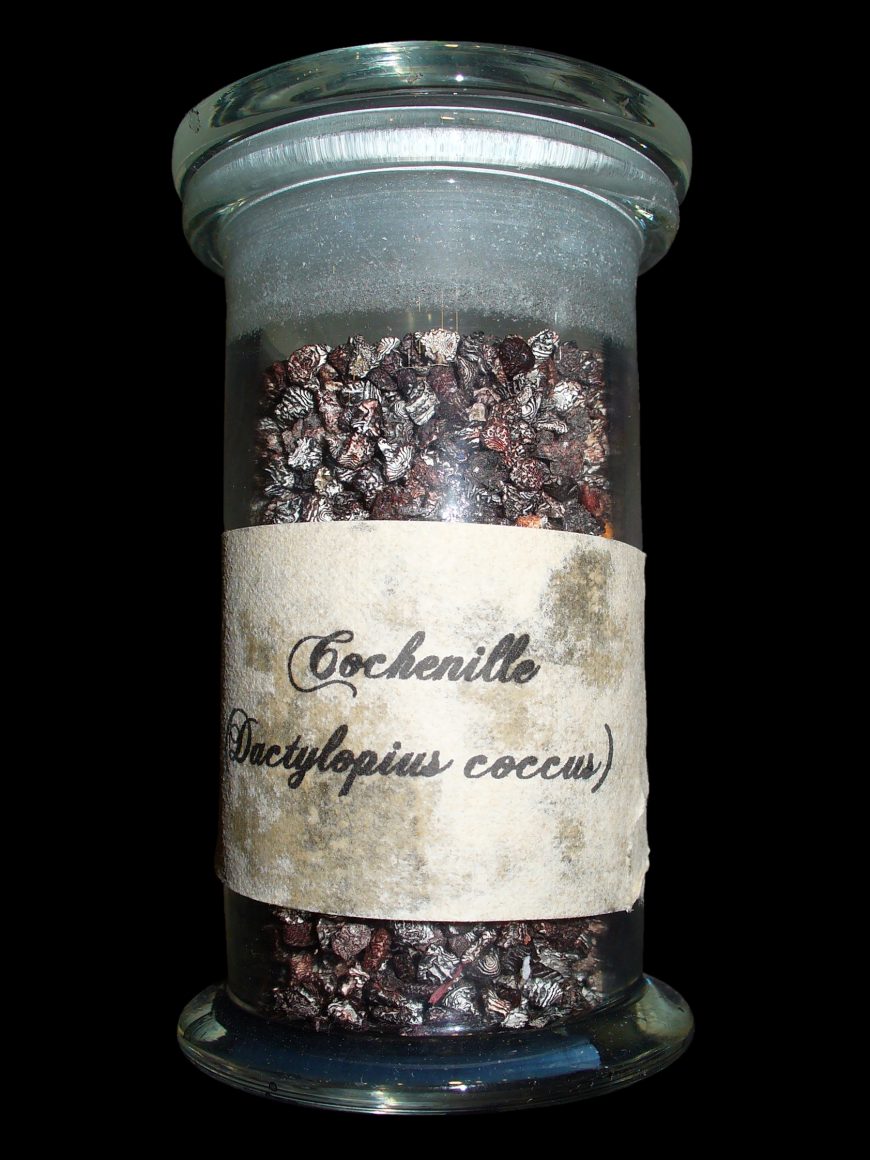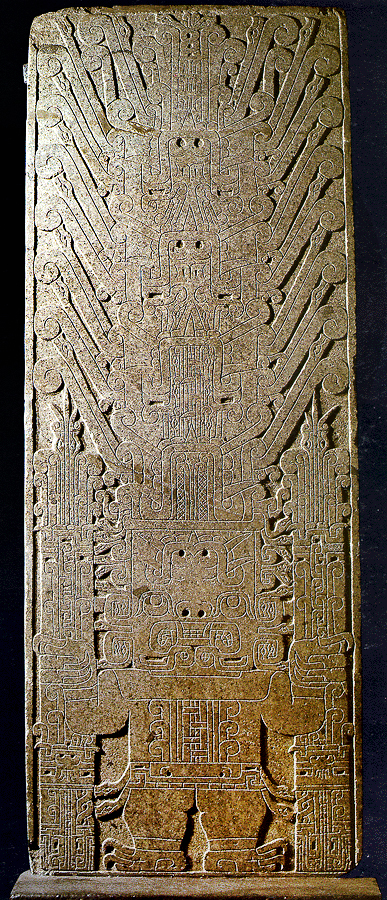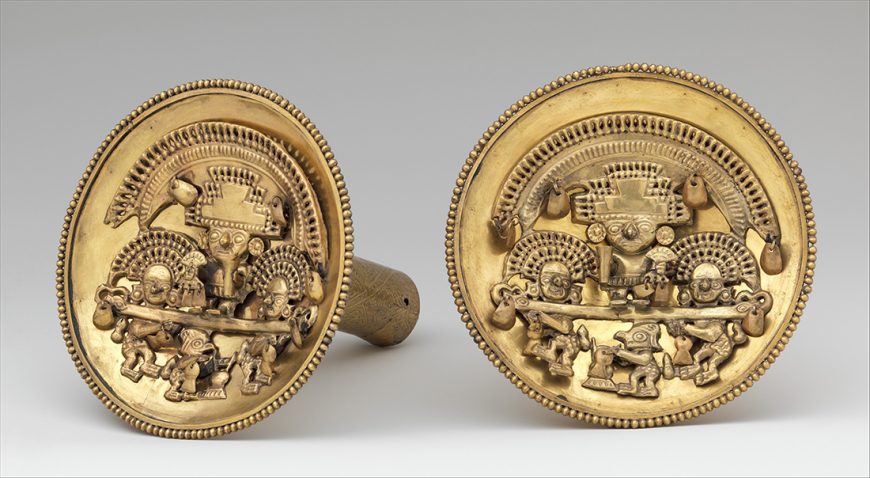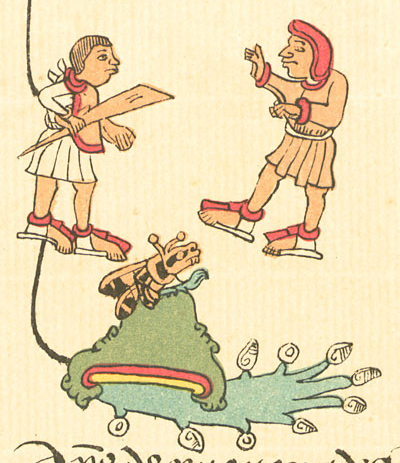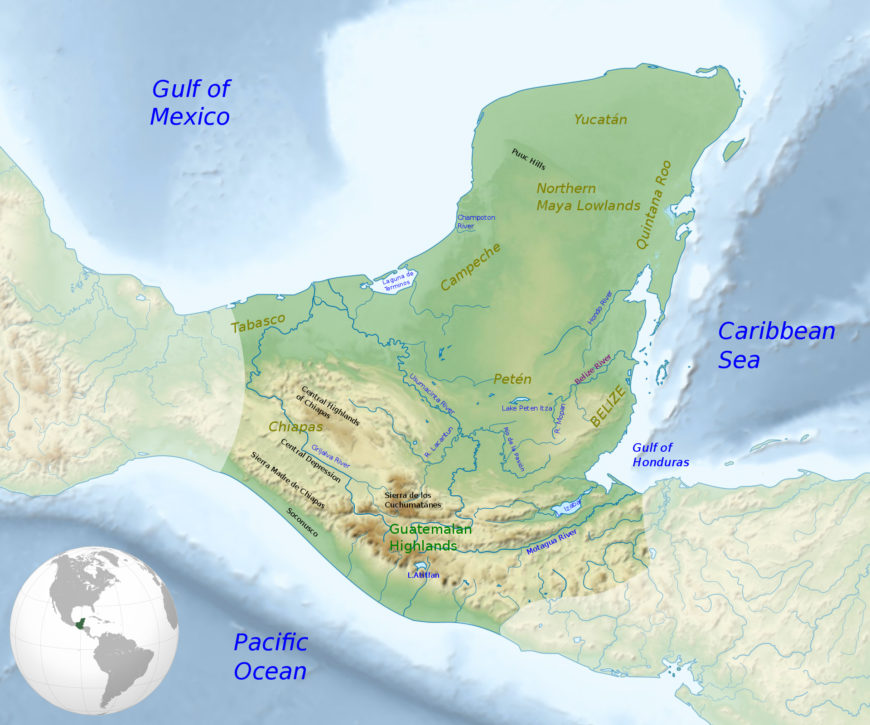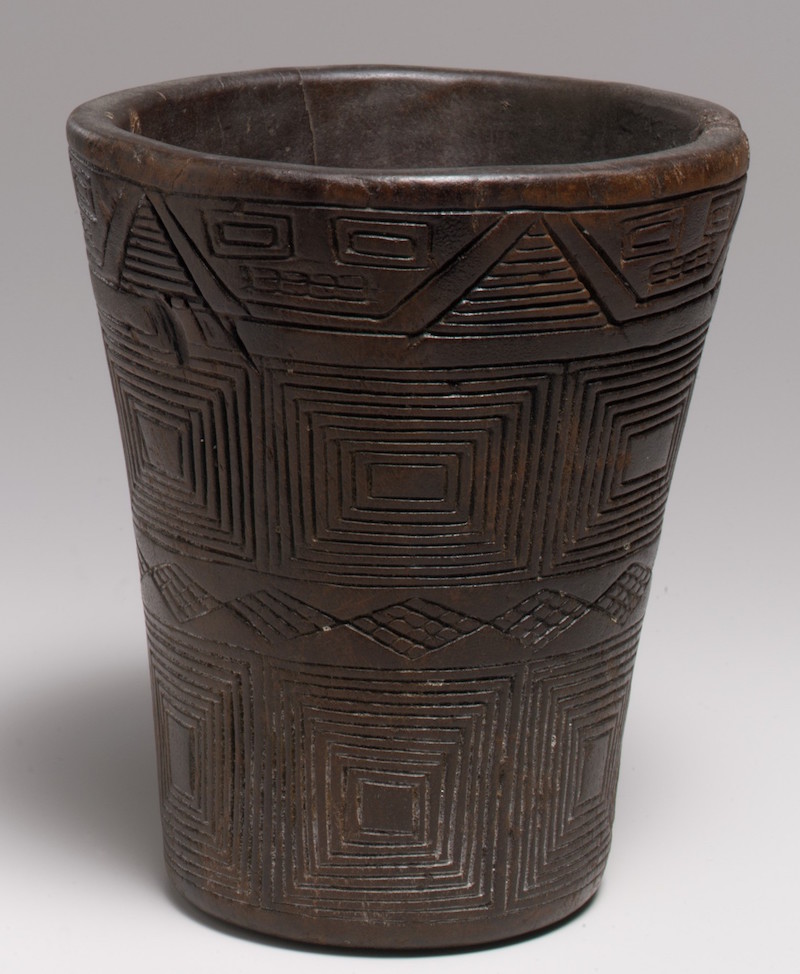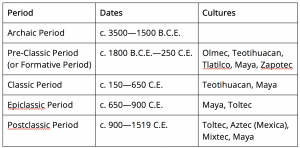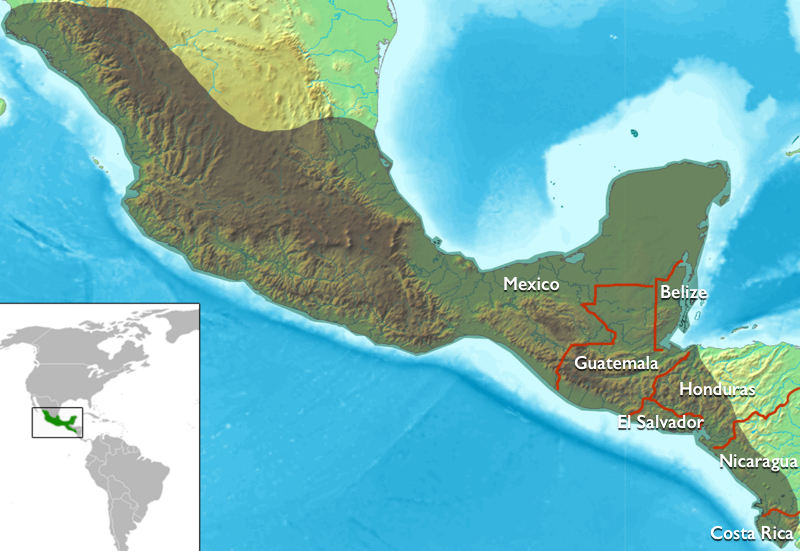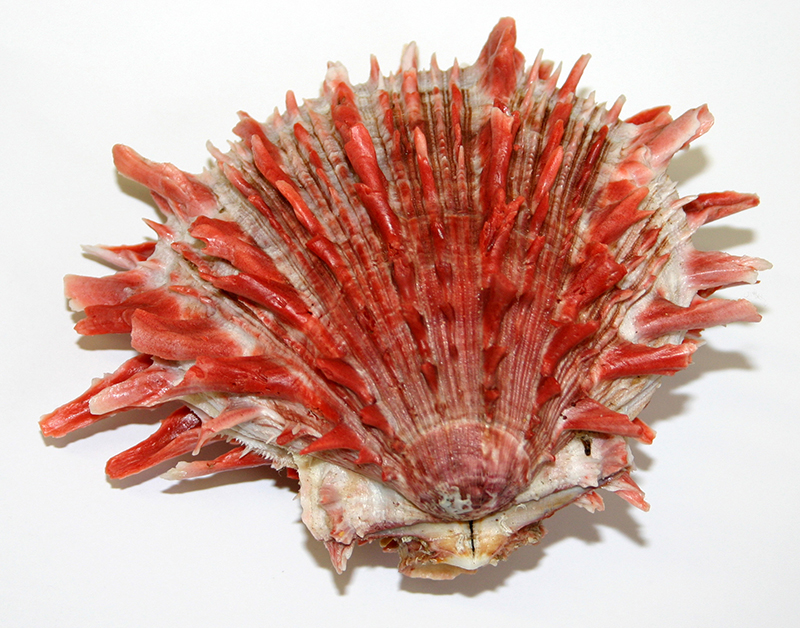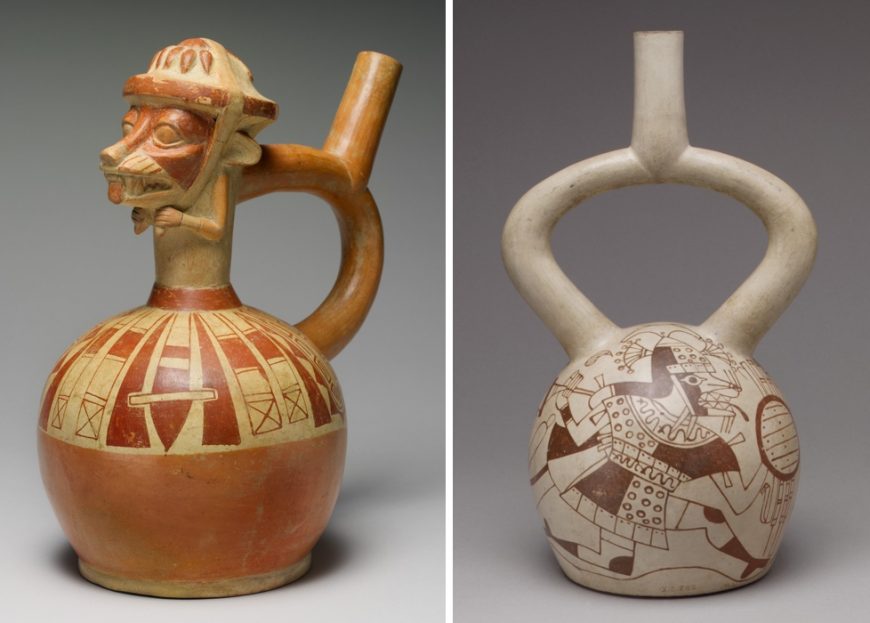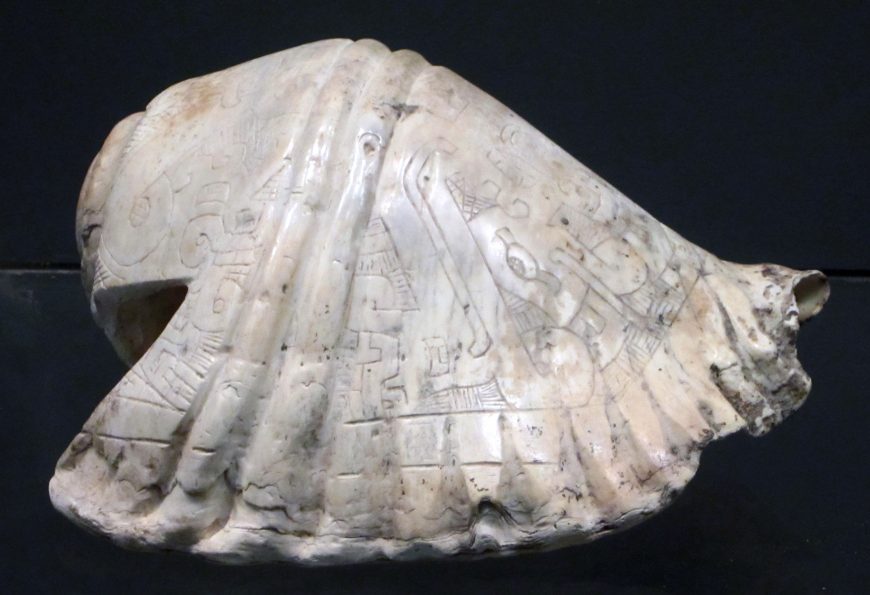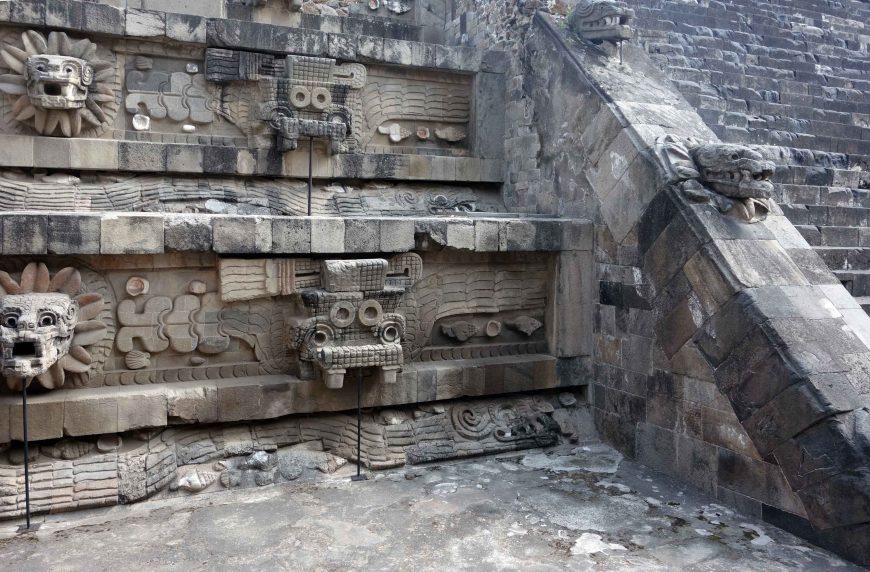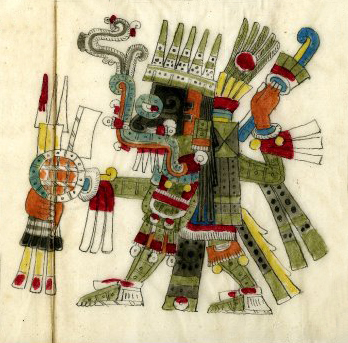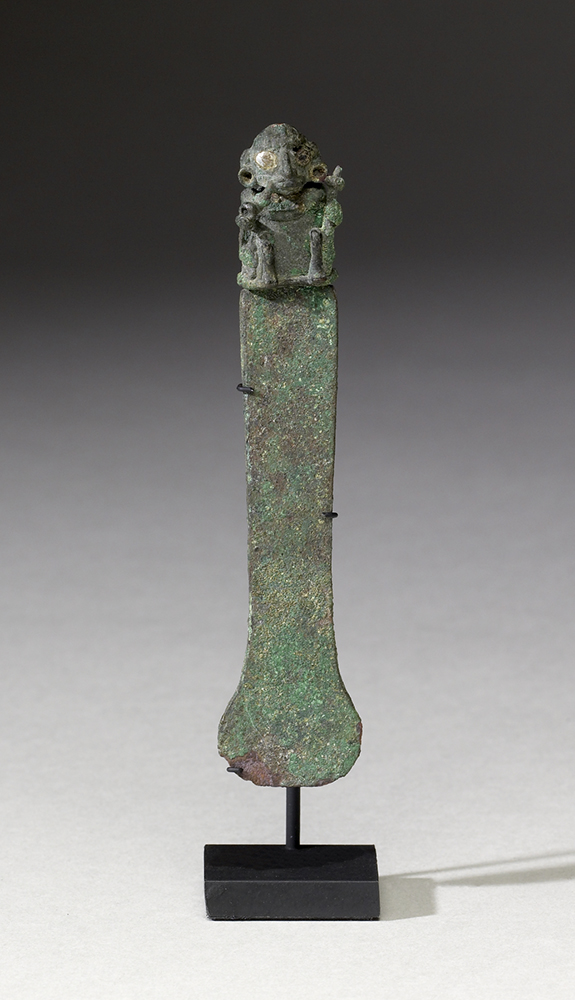A glossary of basic terminology that is often used in discussions about pre-Columbian art. Click on any icon to make it larger.
Test yourself at the end!
| aclla |
A “chosen woman” in the Inka Empire who weaved fine cloth for gods and nobles.
|
| accoutrements | Accoutrements are additional items, such as jewelry, that are worn or used by a person. |
| adobe | Adobe buildings are typically earthen brick structures made of sand, silt, clay, and straw. |
| adzes | An adze is like an axe but its blade is set at a right angle to the handle.
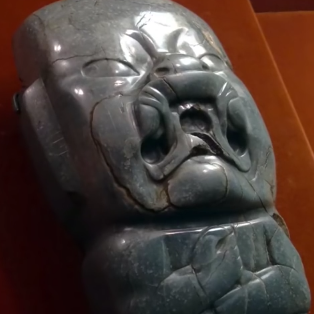 Votive Adze “Kunz Axe,” c. 1200-500 B.C.E., jadeite, 31 x 16 x 11 cm, Olmec Formative Period (American Museum of Natural History, Washington D.C.) |
| alpaca | A type of camelid found in the Andean region. Alpacas have soft wool and were sheared to make textiles.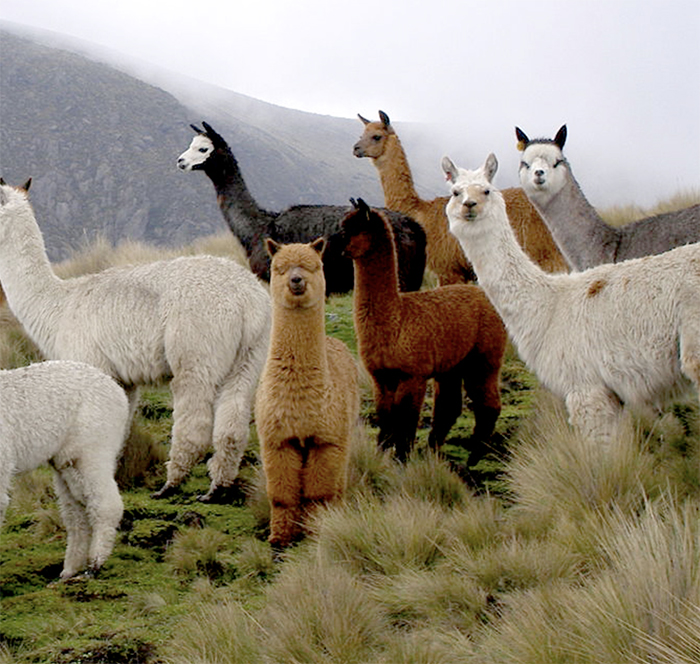 |
| amanteca |
The name for Nahua featherworkers, who comprised their own special social class. In the Mexica capital of Tenochtitlan, they lived in a neighborhood called Amantla, which is why they were called amanteca.
|
| ancestral Puebloans | The ancestral Puebloans were an ancient culture residing in the Four Corners region. Many Pueblo people today consider themselves descendants of this culture. The ancestral Puebloans have sometimes been referred to as the Anasazi, but this term, which is a Navajo word meaning “enemy ancestors,” is considered objectionable by many modern Pueblo people. |
| The Andes |
“The Andes” can refer to the mountain range that stretches along the west coast of South America, but is also used to refer to a broader geographic area that includes the coastal deserts to the west and into the tropical jungles to the east of those mountains. This region is seen as home to a distinct cultural area—dating from around the fourth millennium B.C.E. to the time of the Spanish conquest—and many of these cultures still persist today in various forms.
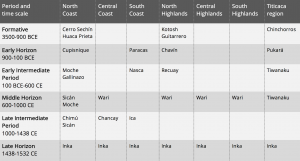 |
| Andean highlands | Located between the coastal deserts and snow-capped Andean mountains, the highlands are home to fertile valleys, plateaus, and grasslands. The highlands are above 8,000 feet. Valleys can have temperate climates, while the plateaus and grasslands can have much colder, more severe weather. |
| anthropomorphic | Anthropomorphic means having a human form. |
| archaic | The word “archaic” refers to art of earlier cultures. |
| art for art’s sake | This term refers to art made purely for the purpose of enjoyment. |
| atl-tlachinolli |
Fire and water, known in Nahuatl as atl-tlachinolli (“burnt water”; pronunciation: at-ul tlach-ee-no-lee), symbolized war, which was essential to the expansion of the Mexica empire.
|
| ayllu | A Quechua word that denotes a network of families that often have a common ancestor. |
| axis mundi | Axis mundi is a Latin term that refers to the concept of a central pole or axis that connects heaven and earth. |
| Aztec | They formed part of a larger ethnic group known as the Nahua from Central Mexico whose pre-Hispanic empire was defeated by the Spanish in 1521. This group of people actually called themselves the Mexica. The name Aztec comes from the word Aztlan (their homeland), and it was appended to this group by the German naturalist and explorer Alexander von Humboldt in the 19th century. |
| bloodletting | The act of shedding one’s own blood, often in a ritual context. Reasons for doing it include to honor deities, and to maintain the cosmos and power. |
| blackware | Vessels fired in a kiln deprived of oxygen (referred to as a “reducing atmosphere”), causing the iron compounds in the clay to turn black. The general term for Andean ceramics made this way is “blackware.” |
| camelid | A camelid is a member of the Camelidae family—think camels, llamas, and alpacas. |
| celts | Celts are smooth, flat implements that are ground from stone, usually tapered, with a cutting edge on at least one of the two ends. |
| ceque | Imaginary lines, called ceques, connected the Inka Qorikancha to shrines throughout the Cusco valley. |
| Chiapas region | Chiapas is a southern Mexican state bordering Guatemala. |
| Chibcha | Also known as the Muisca, who were the last pre-Columbian culture to occupy the Eastern Cordillera of the Colombian Andes and who rose to prominence in 600 C.E. Indigenous people who at the time of the Spanish conquest occupied the high valleys surrounding the modern cities of Bogotá and Tunja in Colombia. |
| chicha |
A type of beer made from maize that was an integral part of Inka social rituals.
|
| Chimor |
The Chimú kingdom that ended after their conquest by the Inka.
|
| chinampas |
Chinampas, or floating gardens, provided the food necessary to sustain the Aztec empire. They consisted of human-made islands where crops could be grown. Food staples included maize, squash, and beans.
|
| coca | There are several species of coca plants. Erythroxylum coca is the variety typically cultivated in the Andean regions discussed here. Coca leaves are the source of the drug cocaine, but when consumed in its organic form, it has less extreme effects. Because of drug trafficking, the cultivation of coca plants is now strictly regulated. |
| cochineal | The cochineal is an insect that lives as a parasite on the prickly pear cactus. When dried and ground, it was used as a red pigment. |
| codex | A word commonly used for screenfold manuscript books. |
| cohoba | Cohoba is a hallucinogenic snuff that was commonly used in Taíno rituals. It was commonly used among indigenous peoples in the Caribbean prior to the arrival of the Spaniards. |
| conquistadors | Conquistador means conqueror, and in this case refers to the Spaniards who invaded Mesoamerica. |
| contour rivalry | Contour rivalry occurs when an image can be interpreted in multiple ways, for instance, when a particular figure can be seen when looked at one way, and a different one appears when the image is turned another way. |
| cornices | A cornice is an architectural element that projects from the top of a wall, either where a wall meets the ceiling, or at the top edge of the exterior of a building. |
| cosmology | Cosmology refers to belief about the order and structure of the universe. |
| ear flare/earspool | A type of jewelry. A cylinder is passed through the earlobe. Earspools were worn by people across the Americas. |
| El Niño | El Niño and La Niña are the warm and cool phases of a recurring climate pattern across the tropical Pacific, the El Niño-Southern Oscillation. |
| flowery war | The flowery wars were ritual wars fought by the Aztecs. |
| Four Corners | The Four Corners region includes southeastern Utah, northeastern Arizona, northwestern New Mexico, and southwestern Colorado. |
| Gateway of the Sun | This name was given to the structure long after the Tiwanaku civilization had collapsed. We do not know if the Tiwanakus associated this structure with the sun. |
| geoglyph | Designs formed on the earth. They are usually constructed from strong natural material, such as stone, and are notably large in scale.
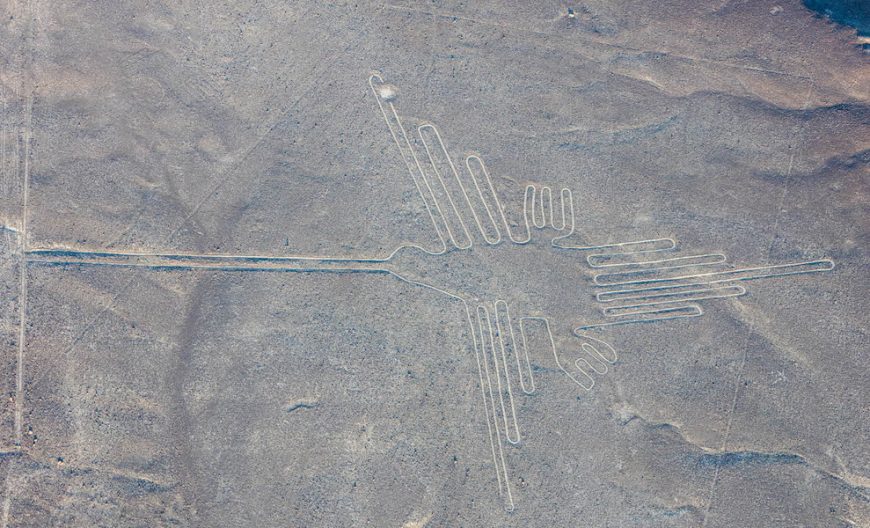 Hummingbird, Nasca Geoglyph, over 300 feet in length, formed approximately 2000 years ago (photo: Diego Delso, CC BY-SA 4.0) |
| gesso | Gesso is a white mixture consisting of a binder, often glue, mixed with chalk, gypsum, or pigment. |
| glosses | Glosses are explanations or interpretations of texts. |
| glyph | A glyph is a symbolic figure or a written character that is based on a picture. |
| Great Houses | A great house is a large, multi-storied Ancestral Puebloan structure.
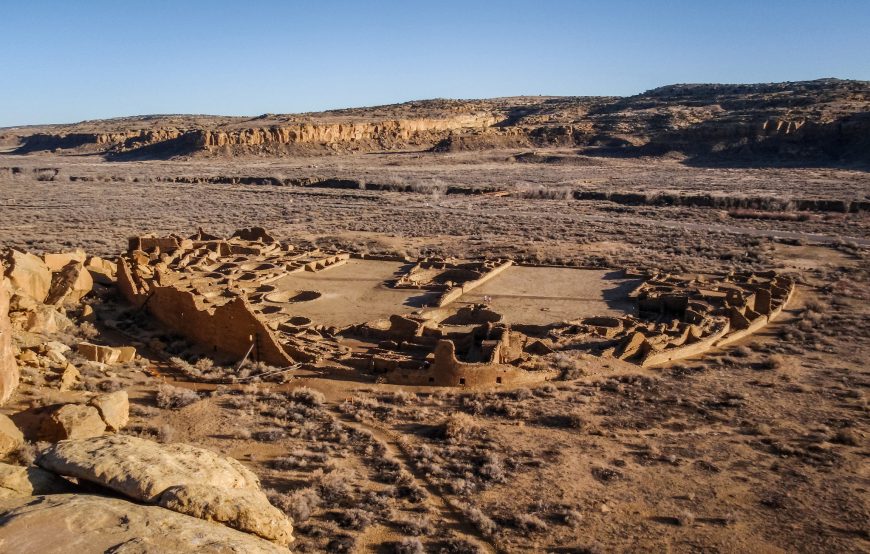 Pueblo Bonito, Chaco Canyon |
| Greater Antilles | The Greater Antilles refers to islands in the Caribbean, including Cuba, Jamaica, Hispaniola, Puerto Rico, Jamaica, and also the Cayman Islands. Hispaniola is formed by the Dominican Republic and Haiti. |
| hanan |
Upper. The city of Cuzco was divided into hanan and hurin.
|
| Highland Maya region | Located in Mexico, Guatemala, and Honduras. The Maya highlands are above 2,600 ft above sea level. The highlands are located south of the lowlands. See also Lowland Maya region. |
| huey tlatoani |
The Mexica ruler was known as the huey tlatoani (“chief speaker”; pronunciation: whey-tla-toe-anee). There were eleven tlatoque (the plural form of tlatoani) of Tenochtitlan, beginning with Acamapichtli in 1375 and ending with Cuauhtemoc in 1525.
|
| huipil | A square-cut blouse worn by indigenous women in Mexico and Central America. |
| Huitzilopochtli | Huitzilopochtli, a god of war who was associated with the sun, is pronounced “Wheat-zil-oh-poach-lee.” |
| hurin | Lower. The city of Cuzco was divided into hanan and hurin. |
| indigo | Indigo is a natural dye derived from the leaves of certain plants. In South America, this is usually the anil plant. |
| Inti | The Inka sun deity. |
| Isthmian | The Isthmian region refers to the North American Isthmus‚ todday, Panama, Costa Rica, and Nicaragua. |
| keru/kero | A ceremonial drinking vessel used by the Inka. |
| La Venta | La Venta is a Middle Formative period (1000–400 B.C.E.) Olmec culture site located in the Mexican state of Tabasco |
| lintel | The beam at the top of a doorway. |
| Lowland Maya region | Located in the northern part of Central America, in the Yucatan peninsula of Mexico, Guatemala, and Belize. The Maya Lowlands range from 25 feet to 2,600 ft above sea level. The lowlands are divided into the northern and southern lowland region. See also Highland Maya region. |
| maguey | Maguey is a type of agave plant. It had several uses, including as an alcoholic beverage and as a glue. |
| maize | Another word word for corn that originally derives from Spanish. |
| manioc | Manioc is a root vegetable, also known as cassava. |
| Mesoamerica |
The region of Mesoamerica—which today includes central and south Mexico, Belize, Guatemala, and the western portions of Honduras and El Salvador—consists of a diverse geographic landscape of highlands, jungles, valleys, and coastlines. Pre-Columbian Mesoamerican cultures shared certain characteristics such as the ritual ballgame, pyramid building, human sacrifice, maize as an agricultural staple, and deities dedicated to natural forces. Some Mesoamerican societies developed sophisticated systems of writing, as well as an advanced understanding of astronomy. Many of these cultural trademarks persisted for more than 2,000 years across civilizations as distinct as the Olmec (c. 1200–400 B.C.E.) and the Aztec (c. 1345 to 1521 C.E.). Read more here.
|
| Mexica | The Mexica (or Aztecs) formed part of a larger ethnic group known as the Nahua from Central Mexico whose pre-Hispanic empire, the Aztec empire, was defeated by the Spanish in 1521. Mexica is pronounced “Mesh-ee-ka.” |
| Mimbres pottery | The Mimbres occupied southwestern New Mexico from about 1000 to 1250 C.E. Mimbres pottery is known for distinctive feather and grid patterns, as well as figurative elements‚ including birds, bats, turtles, mountain goats, and humans. These pots influenced later Pueblo potters. |
| mit’a | Originally an Inka tax paid in labor, it was adopted by the Spanish but without the social reciprocity it originally included |
| mnemonic device | A mnemonic device is a memory aid. |
| mummy bundle | In the Andes, mummy bundles could be wrapped in textiles, and could be buried with offerings of food and jewelry to accompany the deceased into the afterlife. Some of the most elaborate mummy bundles come from Paracas. |
| Nahua | The Mexica (or Aztecs) formed part of a larger ethnic group known as the Nahua from Central Mexico whose pre-Hispanic empire was defeated by the Spanish in 1521. |
| Nahuatl | Nahuatl was the language of the Mexica. Approximately 1.5 million people speak it today, making it one of the most widely-spoken indigenous languages of the Americas. |
| paccha | A ritual watering device, pronounced in Quechua as POCK-cha. |
| pictograph | Visual representations of people, places, and events act like writing. |
| pigments | Pigments are substances used in paint to give it a particular hue. They are often derived from minerals. |
| pre-Columbian |
“Pre-Columbian” refers to the period in the Americas before the arrival of Columbus. It is a problematic term, discussed in more depth here.
|
| puquio |
Gradually descending tunnels that tap ancient subterranean aquifers and water channels. They have been described as wells, and formed part of ancient irrigation systems.
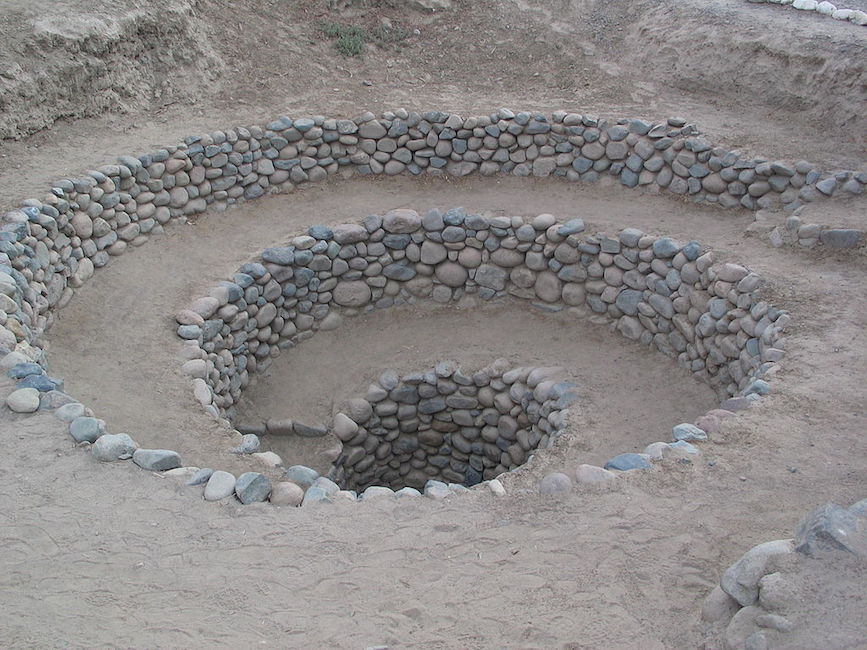 Puquio, South Coast of Peru |
| pututu |
Carved Strombus shells turned into trumpets, some of which have been found at Chavín.
|
| pyroengraving | A technique used to decorate wood or other materials like gourds with burn marks created with a heated object used to engrave or incise the surface of the object. |
| Qhapac Ñan |
The Inka Empire was connected by a road system—the Qhapaq Ñan—that was used for official Inka business only. |
| qompi | The highest quality woven textiles of the Inka Empire. |
| Quechua | The primary language of the Inka, Quechua is still spoken today by approximately 10 million people in South America, primarily Peru and Bolivia. |
| quetzal | Quetzals are colorful birds native to Mexico and the southern United States. |
| quipu | A quipu (or khipu in Quechua) is a knotted string implement that recorded narratives and other types of information.
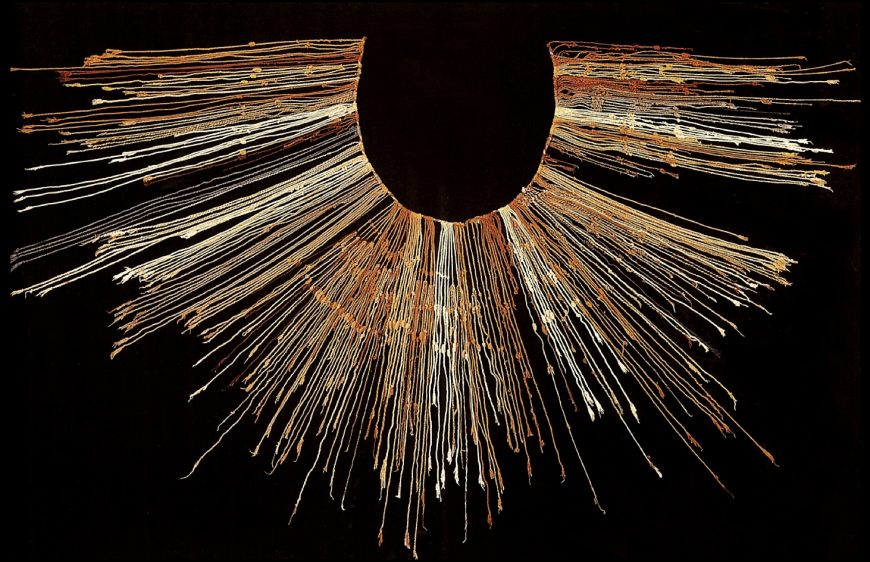 Inka quipu (Museo Larco, Lima, Peru; photo: Claus Ableiter, CC BY-SA 3.0) |
| Raimondi Stele | The stele is named after the Italian-Peruvian geographer and scientist Antonio Raimondi, who first documented the stele in 1874. |
| relief | Relief sculpture remains attached to a surface. |
| repoussé | Repoussé is the technique of hammering silver or other metal into relief from the back side. |
| roof comb | A roof comb is a decorative element on the roof of many Maya structures, sometimes solid stone and decorated with mosaic or stucco and sometimes an open lattice. |
| sapote | A fruit-bearing tree found in Mexico, Central America, and parts of South America. |
| schistose | A form of metamorphic rock prone to flaking. |
| screenfold | A single sheet of paper that is then folded like an accordion. The screenfold is a Mesoamerican construction, strikingly different from European manuscripts whose pages are bound on the left side so the reader sees two pages at a time. |
| sherds | Pottery sherds, or potsherds, are broken pieces of ceramic material. |
| slip | Slip is a liquid mixture of clay and/or other materials suspended in water, it can be used as a paint to decorate ceramics before they are fired. |
| Spondylus shell |
Spondylus shells are not native to Peru; they thrive in the warm coastal waters of what is now Ecuador, hundreds of kilometers from Chavín. |
| stela (or stele) | An upright flat slab of stone worked in relief. |
| stirrup spout | A vessel type commonly used by the Moche culture of the Andes. It is composed of a hollow tube of clay bent into an upside-down U shape, with another tube piercing it at the apex of the curve. |
| Strombus shell | Strombus can be found in Peruvian waters, but that is the southernmost reach of their range—they are more common in the north. |
| talud-tablero | A sloping wall, talud, that is surmounted by a vertical wall, tablero. |
| Tawantinsuyu |
The Inka called their empire Tawantinsuyu, usually translated as “Land of the Four Quarters” in their language, Quechua |
| Tenochtitlan | Tenochtitlan was the capital of the Mexica empire. Today it is known today as Mexico City. It is pronounced “Ten-oach-teet-lan.” |
| tenon head |
Sculptures of heads which are set into a wall, anchored by a post called a tenon, but extend out from the surface.
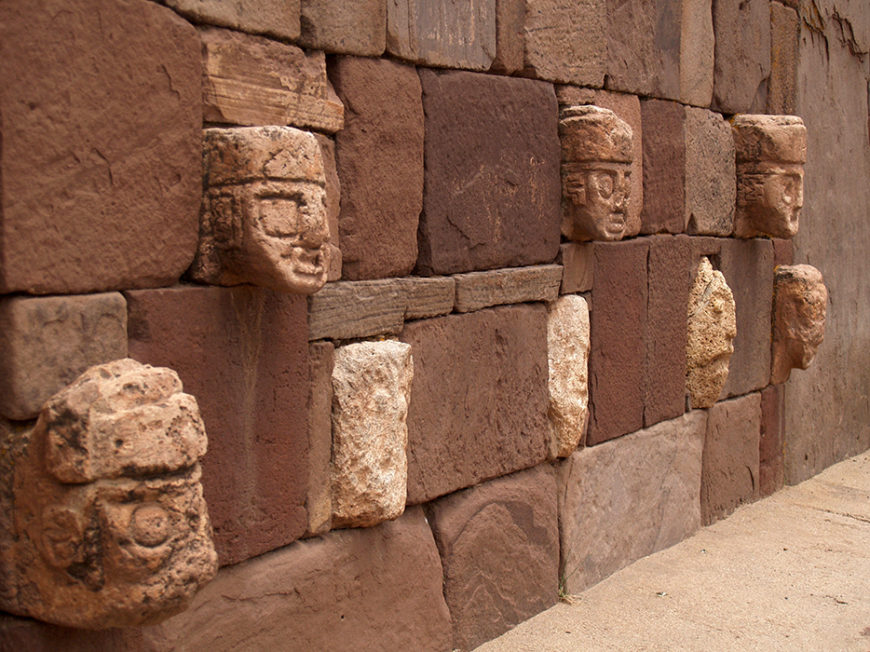 Tenon heads in a wall of the Semi-subterranean Court, Tiwanaku, Bolivia, 300–400 CE (photo: Phil, CC BY-NC-ND 2.0) |
| teocalli | A teocalli is a Mesoamerican pyramid with a temple on top. |
| thatch | Thatch roofs are usually made of straw, leaves, or a similar organic material. |
| Timucua | Timucua, pronounced Tee-MOO-qua, were native Floridians. This once populous people ceased to exist by the early 19th century as a result of European disease, enslavement, and other pressures. |
| Tlaloc | Tlaloc, a rain and agricultural god. |
| Tlaxcala | Tlaxcala was a city-state in central Mexico. |
| tocapu/t’qapu | Tocapu are compartmentalized geometric designs found in Inca textiles.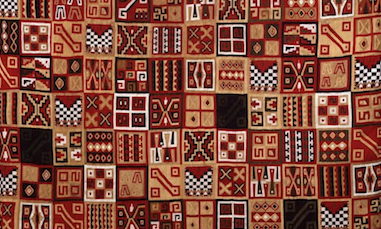 |
| tonalpohualli |
The Aztecs had two different calendars: a 260-day ritual calendar called the tonalpohualli (day count), and a 360-day (plus 5 extra days) calendar called the xiuhpohualli (year count).
|
| tribute | Tribute is a form of payment made to a ruling power or state. |
| tumbaga | Tumbaga is an alloy composed mostly of gold and copper. The proportions can be manipulated to change the color of the metal. |
| tumi | A ceremonial knife used in the Andean region. |
| urpu | A storage vessel that was produced in large quantities throughout the Inka empire. They are characterized by two handles on the lower sides of the vessel and a nub or small projection near the neck, which allowed a rope to be passed through the handles and looped over the nub so that it could be carried on a person’s back or as part of a llama’s pack. The pointed bottom of the vessel allowed it to be pushed into the earth for stability when being stored. |
| xiuhpohualli |
The Aztecs had two different calendars: a 260-day ritual calendar and a 360-day (plus 5 extra days) calendar called the xiuhpohualli (year count). The xiuhpohualli was divided into eighteen months of twenty days each, and each of these months had a festival that honored a specific deity or deities.
|
Test yourself with a beginner’s quiz!
Pre-Columbian terms (beginner)
Test yourself with an advanced quiz!


